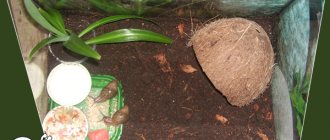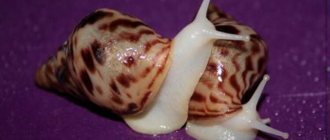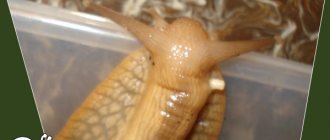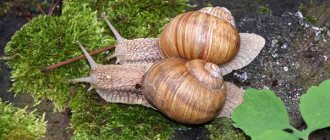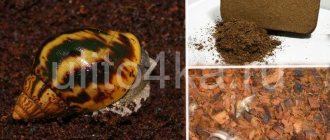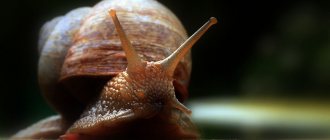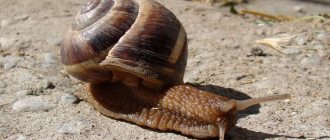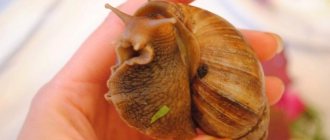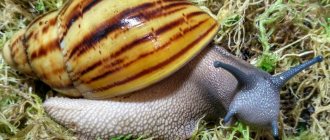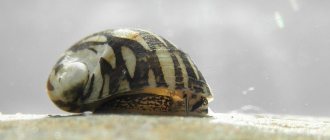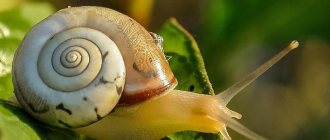Setting up a terrarium for snails is, first of all, recreating conditions close to those in which they live in their natural environment. African snails are big fans of burrowing into the ground and sleeping there from several hours to several days. Therefore, the soil must be of high quality. And its layer is optimal so that the mollusk can completely hide in it.
In nature, Achatina practice resting and hiding under snags and in the winding branches of bushes. In artificial housing, it is necessary to build similar shelters for pets. In addition, at home, housing for pets should not spoil the interior of the apartment, but, on the contrary, decorate it. Therefore, you should think about how to design a terrarium for Achatina snails so that its appearance is aesthetic.
Selecting a primer
Soil performs certain functions. Based on them, you should decide what and how to choose soil for the terrarium. In terms of quality, it must correspond to its purpose:
- Achatina sleeps in the soil, lays eggs, and digs through it in search of food;
- the soil is saturated with moisture and retains it, which helps maintain a constant level of humidity;
- if an animal falls off the wall of an artificial dwelling and falls to the bottom, the soil will soften the fall;
- Living vegetation is planted in the ground.
The substrate must be kept moist at all times, and the soil should be loosened regularly. In addition, it must be safe for shellfish - no fertilizers or parasites.
In African snails, due to their inherent rapid metabolism, the soil quickly becomes dirty with waste products. Therefore, it is important that changing it is easy and quick. Experienced snail breeders know this life hack:
- Take a plastic bag with a bottom that is equal in area to or slightly larger than the bottom of the terrarium.
- The bottom is cut off from the bag with “sides”.
- The bag is placed at the bottom of the terrarium, and soil is poured into it.
- The edges can be camouflaged with snags, dry leaves and moss.
Thus, to clean the terrarium for Achatina, you just need to remove the bag of soil and replace the entire structure with a new and clean one.
How to make ventilation?
For growth and development, Achatina requires humidity and a constant supply of fresh air, which also reduces the likelihood of mold, rot and disease. It is not difficult to organize a ventilation system with your own hands - just drill holes in the container on the roof and sides. The holes should be positioned correctly so that on one side they are located in the upper part, and on the other - in the lower part. As a result, the temperature inside the tank should be between 24 and 27 degrees Celsius. The holes should not be too large, since a wide diameter threatens excessive evaporation and, therefore, changes in humidity levels.
The easiest way to pierce holes is with a regular awl, preheated over a gas stove. You should focus on the hole, the diameter of which will be 3 millimeters.
As a rule, for a 15-liter tank you will need to make 15-20 holes on the lid. The edges of the holes must be sanded. For the sides, a couple of holes on each side will be enough. If too many holes were made during the process, the excess can be covered with any dense fabric, which will additionally create a shady corner in the tank.
To monitor the humidity level and temperature in the tank, experts recommend placing a thermometer and hygrometer inside. As mentioned above, the temperature should range from 25 to 27 degrees. It is recommended to maintain the humidity level within 75-90%. From time to time it makes sense to slightly moisten the soil and also spray the insides of the walls.
Types of soil for Achatina
Pet stores offer high-quality soil in the form of coconut substrate, peat and washed forest soil. You can prepare it yourself. To decide on the soil for your pets, you need to know the characteristics of the materials. And then make a choice in favor of one or the other.
Coconut soil is optimal for shellfish. It is commercially available in the form of briquettes: the dried block is soaked and converted into soil. This substrate will not stain the walls, retains moisture for a long time, and mold will not grow on it. But food for Achatina should not be placed on it. When using this type of substrate, food should be placed in a feeder or on a lettuce leaf.
Peat - a specially prepared substrate, from a pet store - is also a good option. Many owners of Achatina simply keep them on soils of different compositions from pavilions selling indoor plants. Or on soil collected from the forest. But in both options, such soil must be thoroughly poured with boiling water or fried in the oven. Peat retains moisture well. Moss and dry leaves are placed on top of it. In such soil, seeds of decorative terrarium plants germinate well and seedlings take root. Plants in the terrarium of African snails are not only interior decoration, but also food for these mollusks.
Sphagnum (one of the types of bog mosses) is also suitable for Achatina. It not only maintains humidity, but also plays the role of a barometer in the terrarium.
- If the sphagnum begins to dry, this means that the required level of humidity in the terrarium has decreased.
- If it turns green, everything is fine.
Moss does not need to be changed as often as other types of soil, and it looks aesthetically pleasing. The only “but” is that moss is not suitable for small Achatina, such a terrarium is not suitable for a large snail. Small individuals simply will not be able to bury themselves in such litter.
Keepers of snails do not like sand . On the one hand, these are African snails, sand is their habitat. On the other hand, sand does not retain moisture, sticks to the snail’s body and shell, and even scratches the walls of the terrarium. In addition, grains of sand clog the mollusk’s digestive system, which can lead to the early death of the pet.
Sawdust is an undesirable soil, since it practically does not absorb moisture, which is why it begins to stick together and rot. Their sharp edges can injure Achatina’s body. Breeders know that if a snail is kept on sawdust for a long time, its shell will become covered with a white, indelible coating.
It is strictly forbidden to keep Achatina on a rocky bottom - it is impossible to bury itself in gravel. A snail can also break its shell by falling from the wall to the bottom.
Content Features
Since this type of mollusk is quite vulnerable for the Russian climate, the conditions for keeping them should be as close as possible to their natural environment, namely the subtropics. The best option for keeping snails is an achatina aquarium, since it is in it that it is easiest to artificially reproduce the required microclimate, which includes:
- absence of drafts;
- a certain level of humidity;
- constant temperature;
- no direct sunlight.
In this video you will learn more about the snail terrarium:
An important criterion for assessing the condition of this type of pet is their level of activity.
Terrarium houses for Achatina
All snails are nocturnal animals. During daylight hours they rest in shelters. Therefore, in artificial conditions, Achatina needs a house. They can serve:
- half a coconut shell;
- bark of tree;
- snag or woven branches;
- as a last resort - a small ceramic flower pot (you need to put wet moss in such a house).
If the snail has nowhere to rest without prying eyes, the mollusk will experience stress. The pet will stop eating and may fall into a state of suspended animation.
Home decoration
The design of the “house” of mollusks occurs with the help of plants, both living and artificial, as well as various decorative elements. The latter must be made from natural materials that are environmentally friendly for the health of the pet. In addition, it is important that there are no sharp edges or surfaces that could cause injury to shellfish.
Decorating the walls of the terrarium
The question of how to arrange a terrarium for the Achatina snail is also the task of fitting it into the interior of the room where the snails are kept. The main role is played by the back wall - it can be decorated with a film with a pattern, which is fixed from the outside. Pet stores offer a huge selection of landscapes; you can also order mini photo wallpapers to your liking from a printing house.
An option for craft fans is to glue moss, twigs, and pieces of tree bark onto cardboard with silicone glue. You can take a cork or bamboo panel. Natural materials for the back wall are needed, because African snails are part of wildlife.
Caring for a snail aquarium
You have equipped a house for the Achatina snail, arranged it, released the mollusks, now you need to think about cleaning. The house is cleaned as it gets dirty. It is recommended to completely flush the aquarium at least once every 14 days. To keep your snails comfortable, wash the walls and inside of the lid every day.
The cleaner the aquarium for Achatina snails, the healthier your pets. When cleaning the tank, do not use chemicals. The skin of shellfish is very sensitive, so cleaning powders can cause thermal burns.
It is recommended to rinse the tank under running hot water without adding chemicals or soapy water. The walls can be wiped with a damp sponge. Provide separate cleaning equipment for washing the terrarium and store it separately from other items.
Achatina quickly become favorite pets. It is interesting to watch them, feed them, and care for them. Pets do not require special care, but you need to pay enough attention to the arrangement of your home. Health and comfort depend on the correct arrangement of the terrarium of the Achatina snail. If you decide to have an Achatina, think through and prepare a comfortable house first.
Description
Snails are gastropods with a spiral outer shell. The structure includes a head, a leg and a bag of entrails. They move along surfaces using their legs, which secrete mucus. The body size of snails varies among species from a couple of cm to several tens.
How long do they live at home?
The lifespan of snails at home depends on their size, breed, and natural habitat. Aquatic snails have a short lifespan and do not exceed 4 years. Shellfish, which live primarily on land, live up to 10 years. Some long-lived species, for example, the grape species, can live up to 20 years.
Nutrition
The frequency of feeding depends on the age of the mollusk. Small representatives require feeding several times a day, while adults are fed once every 1–2 days. The pet can go without food for up to 2 weeks, but you should not abuse this.
The daily diet of snails mainly consists of vegetables, fruits and vegetation. We wrote more about snail nutrition separately.
Authorized products:
- Vegetables (tomatoes, cucumbers, cabbage).
- Fruits (bananas, apples).
- Leaves (grape, dandelion, spinach, lettuce).
- Berries (strawberries, wild strawberries, raspberries).
- Oatmeal, bran.
- Protein feeding 1-2 times a week (gammarus, daphnia).
What not to feed:
- Spicy.
- Roast.
- Smoked.
- Sweet.
- Salty.
- Citrus (oranges, lemons, tangerines).
- Pasta.
- Bread.
Unusual pets
Achatina, the giant African snail, will give many pets a run for their money.
Thanks to their positive characteristics, snails very quickly gain favor in a variety of circles and even among those who have never before decided to have a pet. Achatinas are unpretentious, they do not need to be walked, they do not need to be cleaned after them, they do not make noise, do not chew slippers and do not tear upholstered furniture. A terrarium for Achatina is a decoration for the home interior, which is why many owners get them for themselves when they live alone or when they would like to create a corner with wildlife in the house, if there are concrete walls around, and the interior of the apartment is more reminiscent of a production workshop.
Achatina is practically inaudible: when they emerge from their “hiding”, you can watch them for a long time and with interest, sitting in a classical-style chair. How and why giant snails have become a trend among homeowners, what they need to coexist safely next to humans, and how to decorate the interior of an apartment with them, you will learn from the article.
